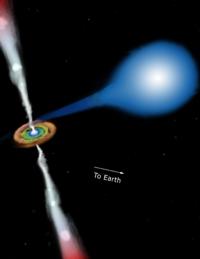SS 433

Mica schist. Credit: US National Parks Service.
SS 433 is an X-ray binary and the first discovered member of a group of very exclusive objects that have to be known as microquasars. SS443 lies about 18,000 light-years away in the constellation Aquila within a 40,000-years-old supernova remnant designated W50.
SS433 consists of a normal O or B star, with a mass of 10 to 20 solar masses, in a 13.1-day orbit around a compact object that is either a neutron star or a black hole. Material transfers from the normal star into an accretion disk surrounding the compact object blasting out two jets of ionized gas in opposite directions at about a quarter of the speed of light. In addition the jets precess (wobble like a top) with a period of about 164 days. Radio studies show that the jets extend to 0.16 light-year from the central "engine", while X-ray studies reveal emission from about 100 light-years on either side, where the jets interact with the surrounding supernova remnant.
SS433 gets its name because it is object number 433 in the Stephenson-Sanduleak catalogue of stars with strong emission lines compiled by two astronomers at Case Western Reserve University, Bruce Stephenson and Nicholas Sanduleak, in 1977.
| visual magnitude | 14.2 |
| distance | 18,000±700 light-years (5,500±200 pc) |
| position | RA 19h 11m 49.56s, Dec +04° 58' 57.6" |
| other designations | V1343 Aql, 4C 04.66, 1RXS J191149.7+045857, 4U 1908+05 |


